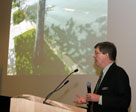| Texas A&M University not only produces leaders, the institution
itself frequently leads the higher-education pack, as is the
case with the idea for an on-campus symposium where faculty share
their research with colleagues, developed by architecture dean
Tom Regan.
“It is unusual for a college such as ours to take ‘time
out’ for a day and cancel our usual schedule of classes,
design studios and meetings to hear other faculty members report
on their current research,” Regan says. “But this
idea has worked so well for us, we’re doing it for the
eighth year in a row. And the concept has spread to many other
architecture colleges across the country.
“One of our college’s core values is the influence of research
on teaching and practice, and this symposium serves as a catalyst
for research-informed teaching in our three undergraduate and
nine graduate degree programs. These research presentations allow
everyone to benefit from current research in the college, and
it is fitting for us in our role as the largest college of our
kind in the nation to establish new traditions that clearly connect
scholarly research with professional education.”
The day-long research showcase, held Monday (Oct. 30), featured
55 faculty presentations previously delivered at scholarly venues
in 34 countries around the world during the 2005-06 academic
year.
“The individual sessions comprising the symposium reflect
all aspects of the designed environment,” said Lou Tassinary,
associate dean for research at the College of Architecture. “The
categories were not predetermined, but rather reflect themes
that have emerged in the work of faculty over the past year.”
Organized thematically, presentations examined ongoing research
in studio pedagogy, architectural theory and design, art, healthcare
architecture and planning, disaster planning and mitigation,
3-D modeling and animation, sustainable urbanism and design,
historic preservation, construction science, the architecture
of place, visualization, energy conservation, housing, land development
and facility management.
Texas A&M architecture professor Roger Ulrich, the most internationally
cited and quoted researcher in evidence-based healthcare design,
delivered the keynote address on “Biophilic Design of Healthcare
Environments.”
Biophilic design, Ulrich said, is a sub-area of the larger field
of evidence-based design influenced conceptually by Harvard naturalist
Edward O. Wilson’s biophilia hypothesis — the notion
that evolution has left modern humans with a partly genetic affinity
for nature. Ulrich’s presentation summarized biophilia
theory and scientific research pertinent to designing healthcare
settings that promote better medical outcomes.
“In older hospital rooms, you usually can cut the stress
and anxiety with a knife,” Ulrich said. “The new wave
in hospital design is founded upon evidence that the built-environment
can
either heighten psychological, physiological and social stress,
resulting in unfavorable medical outcomes, or it can reduce such
stress, increasing the odds for better recovery. When you look
at hospitals designed based on this evidence, you know at once
that these buildings are different – and better.”
| |

Texas A&M architecture professor Roger Ulrich, the most internationally
cited and quoted researcher in evidence-based healthcare design, delivered the
keynote address on “Biophilic Design of Healthcare Environments.”
|

